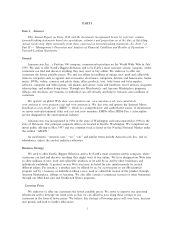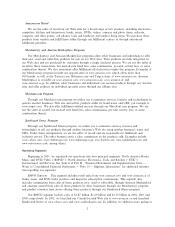Amazon.com 2002 Annual Report Download - page 18
Download and view the complete annual report
Please find page 18 of the 2002 Amazon.com annual report below. You can navigate through the pages in the report by either clicking on the pages listed below, or by using the keyword search tool below to find specific information within the annual report.seasonal demand. Finally, we, along with our customer service outsourcers, may be unable to adequately
staÅ customer service centers.
We generally have payment terms with our vendors that extend beyond the amount of time necessary
to collect proceeds from our customers. As a result of holiday sales, at December 31 of each year, our
cash, cash equivalents and marketable securities balances reach their highest level (other than as a result
of cash Öows provided by investing and Ñnancing activities). This operating cycle results in a corresponding
increase in accounts payable. Our accounts payable balance will decline during the Ñrst three months
following year-end, which will result in a decline in the amount of cash, cash equivalents and marketable
securities on hand.
We May Experience SigniÑcant Fluctuations in Our Operating Results and Rate of Growth
Due to our limited operating history, our evolving business model and the unpredictability of our
industry, we may not be able to accurately forecast our rate of growth. We base our current and future
expense levels and our investment plans on estimates of future net sales and rate of growth. Our expenses
and investments are to a large extent Ñxed. We may not be able to adjust our spending quickly enough if
our net sales fall short of our expectations.
Our revenue and operating proÑt growth depends on the continued growth of demand for the products
oÅered by us or our sellers, and our business is aÅected by general economic and business conditions
throughout the world. A softening of demand, whether caused by changes in consumer preferences or a
weakening of the U.S. or global economies, may result in decreased revenue or growth. Terrorist attacks
and armed hostilities create economic and consumer uncertainty that could adversely aÅect our revenue or
growth. Such attacks and security concerns could create delays in and increase the cost of product
shipments to and from us, which may decrease demand. Revenue growth may not be sustainable and our
company-wide percentage growth rate may decrease in the future.
Our net sales and operating results will also Öuctuate for many other reasons, including:
‚ our ability to retain and increase sales to existing customers, attract new customers and satisfy our
customers' demands;
‚ our ability to expand our network of sellers, and to enter into, maintain, renew and amend on
favorable terms our strategic alliances;
‚ foreign exchange rate Öuctuations;
‚ our ability to acquire merchandise, manage inventory and fulÑll orders;
‚ the introduction by our competitors of Web sites, products or services;
‚ changes in usage of the Internet and online services and consumer acceptance of the Internet and
e-commerce;
‚ timing and costs of upgrades and developments in our systems and infrastructure;
‚ the eÅects of strategic alliances, acquisitions and other business combinations, and our ability to
successfully integrate them into our business;
‚ technical diÇculties, system downtime or interruptions;
‚ variations in the mix of products and services we sell;
‚ variations in our level of merchandise and vendor returns;
‚ disruptions in service by shipping carriers;
‚ the extent to which we oÅer free shipping promotions; and
9
























